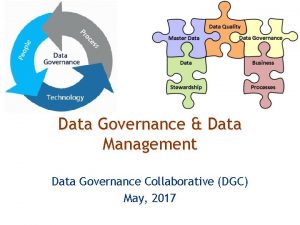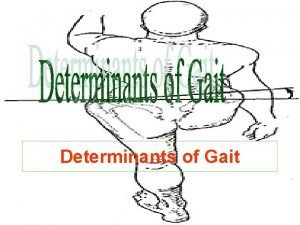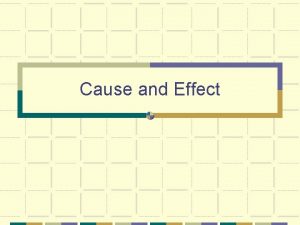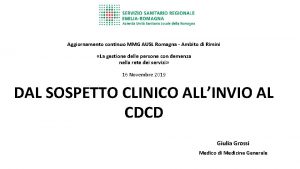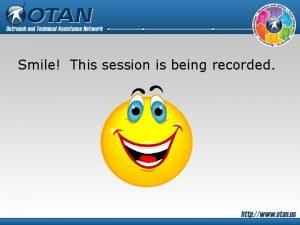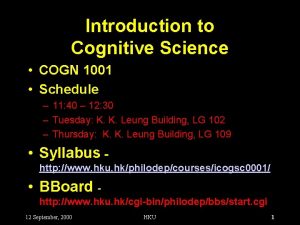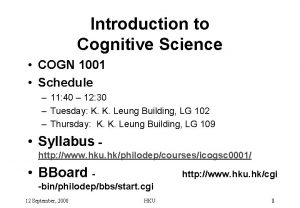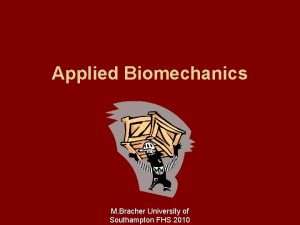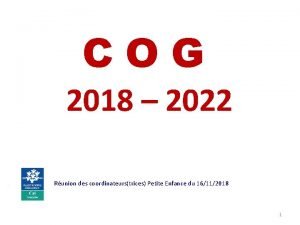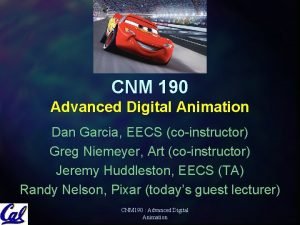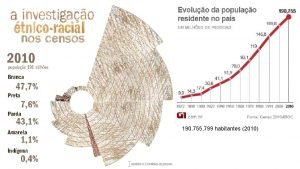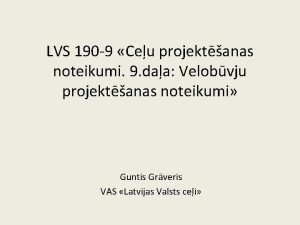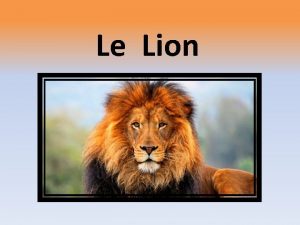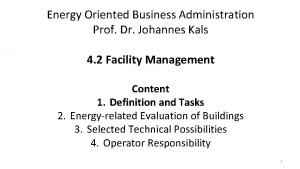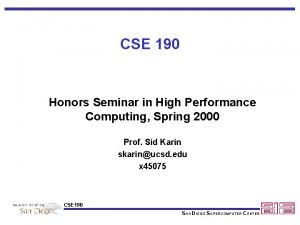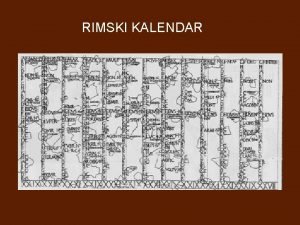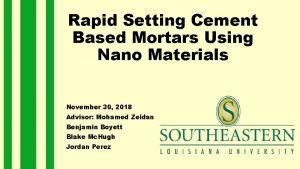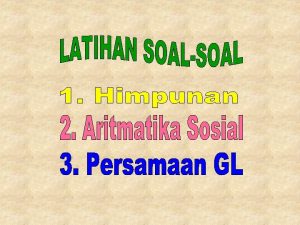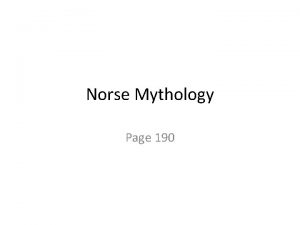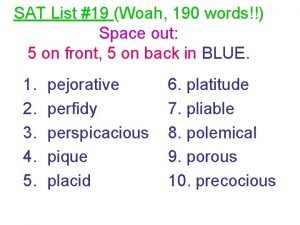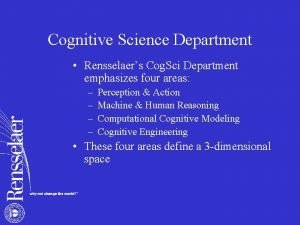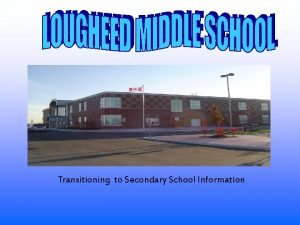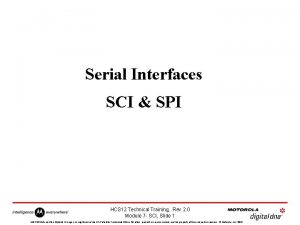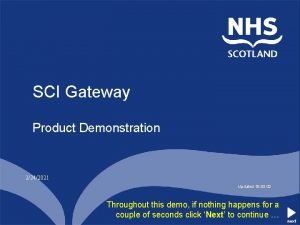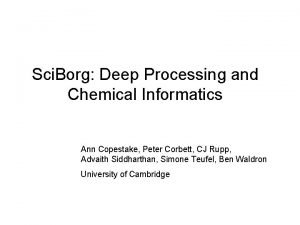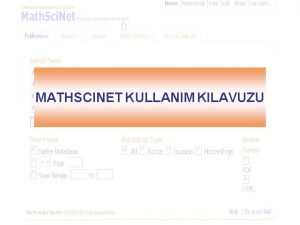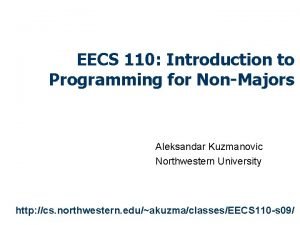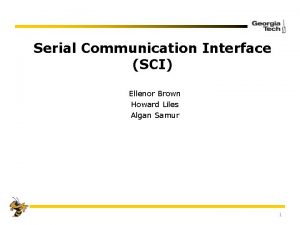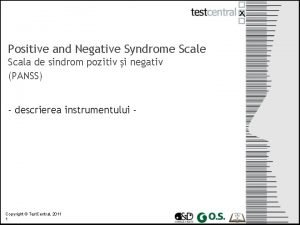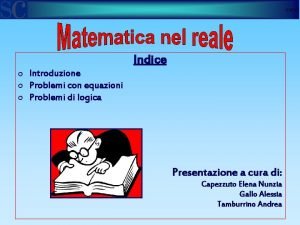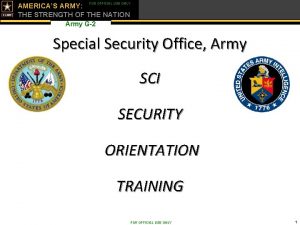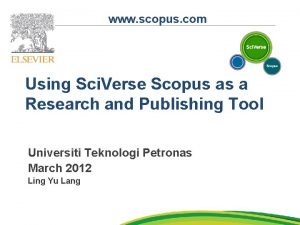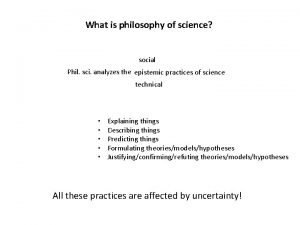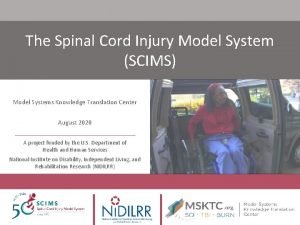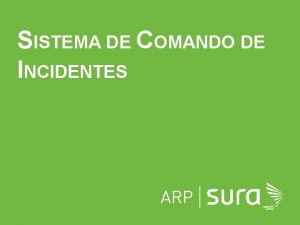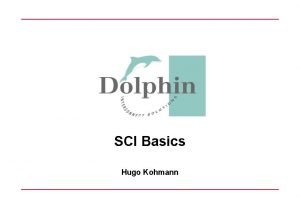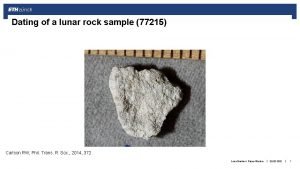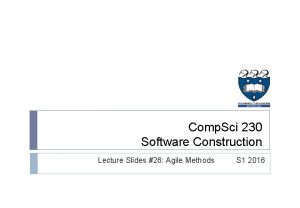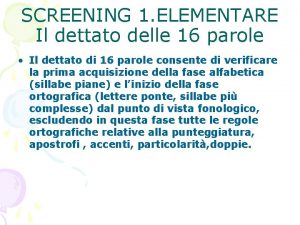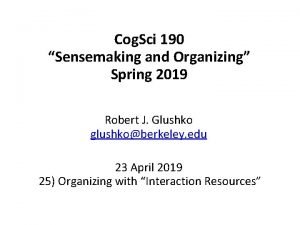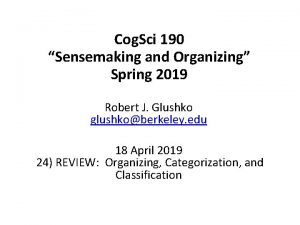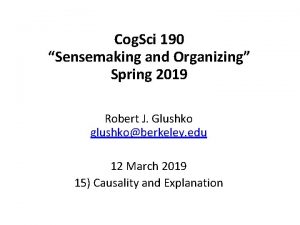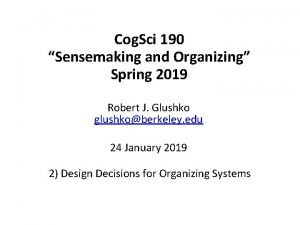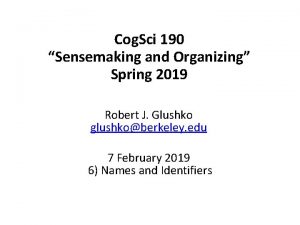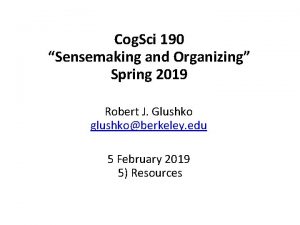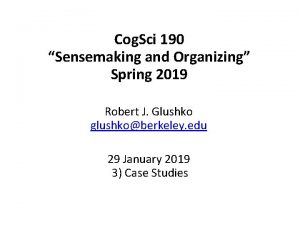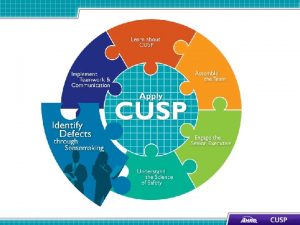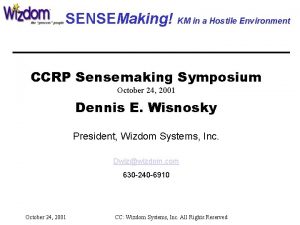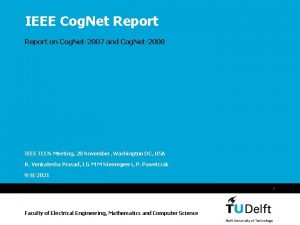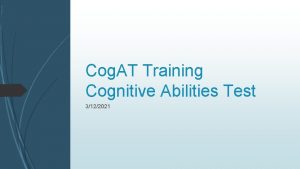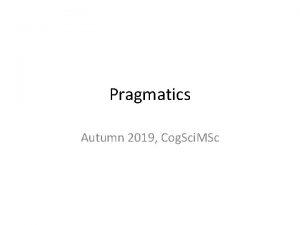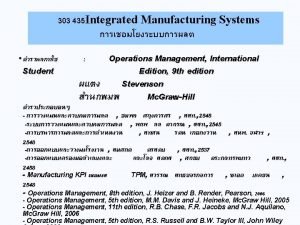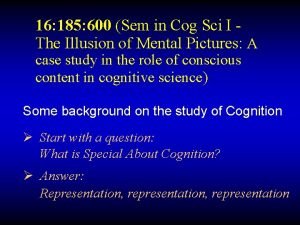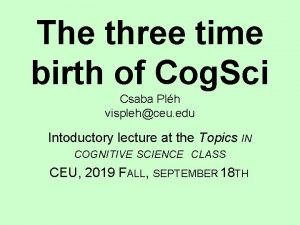Cog Sci 190 Sensemaking and Organizing Spring 2019







































































- Slides: 71

Cog. Sci 190 “Sensemaking and Organizing” Spring 2019 Robert J. Glushko glushko@berkeley. edu 19 February 2019 9) Resource Description

An Introduction to Resource Description What is a resource description? l. Why do we describe resources? l. What resource properties should be described? l. How are resource descriptions created? l. What makes a good resource description? l 2

What is a Resource Description? Information that is created intentionally and associated with a resource to enable it to be organized and interacted with l. Structured descriptions of information resources are often called “metadata” (“data about data”) but… l 3

Let Me Say it Another Way • Resource description and organizing are intrinsically connected • You can’t organize what you haven’t described implicitly or explicitly. . because the principles embodied in any organizing system reflect decisions about what resource descriptions to use

A Resource

Metadog, not Metadata dans Les Baux-de-Provence, 8 Août 2013

FLASHBACK Concert Ticket: A Resource Composed of Resource Descriptions • The distinction between resource and resource description is sometimes subtle and arbitrary 7

FLASHBACK Concert Calendar: A Resource Composed of Resource Descriptions l A resource description is also a resource from the perspective of any other resource that uses it, ad infinitum (TDO 4. 2. 4, 4. 2. 5) Ticketmaster Festival Guide 23 October 2017 8

Why We Describe Resources We describe resources so we can refer to them, select them, organize them, interact with them (especially to compare them), and maintain them l Each purpose might require different descriptions and different methods of using them l Different resource domains can have characteristic or standard resource descriptions (or description categories) l 9

Resource Descriptions as Substitutes l A resource description is often a functional substitute for the resource it describes when the latter can’t be accessed or used easily l Digital descriptions of physical resources enable interactions that are otherwise impossible 10

Two Collections of the Same Resource Descriptions

Selection Criteria Utility for some specific purpose l Intrinsic value l Scarcity or uniqueness l Newest l To establish a brand or reputation l… l FITNESS FOR USE l 12

Computational Descriptions of People l l A great deal of data is collected about people and is then used to make predictions about their future behavior This data drives “predictive analytics” techniques that determine whether to give you credit, to hire / fire / promote you, to arrest / sentence you, to change your diet or exercise routine, or which resources to show you on Google, Facebook, Twitter, Amazon, etc. 13

Describing the Information <Book> <Title>The Discipline of Organizing</Title> <Editor>Robert J. Glushko</Editor> <Publisher>MIT Press</Publisher> <Publication. Date>2013</Publication. Date> <ISBN>978 -0 -262 -51850</ISBN> <Keyword>Classification</Keyword> <Keyword>Resource Description</Keyword> </Book> Describing the Thing <Book> <Weight unit=“pound”>2. 58</Weight> <Height unit=“inch”>9. 25</Height> <Width unit=“inch”>8. 25</Width> <Pages>540</Pages> <Spine. Color>White</Spine. Color> </Book> 14

Organizing Birds for Scientists 15

Organizing Birds for Birdwatchers 16

In data science, resource descriptions are typically called “properties” or “features” in a dataset like this…

Process of Describing Resources (TDO 5. 3) Identify / scope the resources to be described l Determine the uses of the descriptions l Study the resource(s) to identify descriptive properties l Design the description vocabulary l Design the description form and implementation l Create the descriptions (either "by hand" or by some automated / computational process l Evaluate the descriptions l 18

What is a Resource? When you look at, refer to, or pick up a natural physical object, it usually seems that it is "one thing" l But many things have highly visible parts or internal structures, and we must consider whether to treat them as assemblies or aggregations of these separate things l For digital and computational resources, it is much harder to know how many parts we can or should identify l 19

Scoping and Description How explicit and thorough these 7 steps need to be depends on what we are calling "scope“ l. Do we know who the users are? l Are the describers the users? l. Do we have all the resources, a representative set, or just the first set. . . do we know what else is coming? l 20

Description is Challenging! People use different words for the same things, and the same words for different things (TDO 4. 4) l. Describing and organizing always (explicitly or implicitly) takes place in some context l The context shapes which resource properties are important and the organizing principles that use those properties 21 l

Describe This Resource

















Possible Features Category name l Capacity l Weight l Material of manufacture l Size l Shape l Exterior color l Interior color l Exterior finish l Interior finish l

Possible Features Primary use l Other use(s) l Current contents l Previous contents l Reusable? l Stackable? l Nestable? l Transparent? l Insulated? l Decorated? l Branded? l # of Spouts l Stem? l Lid? l Measurement marks? l

Possible Features Manufacturer name l Process of manufacture l Place of manufacture l Date of manufacture l Vendor name l Vendor location l Unit price l Bulk price l Previous unit price(s) l Previous bulk price(s) l

Possible Features Current location l Previous location(s) l Current user l Previous user(s) l Date of first use l Date of most recent use l

Possible Features Handle? l #of Handles l Handle material l Integrated handle? l Separate handle? l Decorative handle? l • • • Animal handle? Bird handle? Toucan handle? Fish handle? Lizard handle?

If this is all you’re given, give up!

Resource Description Concerns for Data Scientists l Is the dataset relevant to the questions you’re asking? l Do you understand the descriptions and their values? l Are the values accurate? Stable? Current? l Are they human-interpretable? l Did the people who designed or created them understand them in the same way? l l Levels of measurement, granularity / precision, open vs. controlled vocabularies Did they have the same purposes/interactions in mind? 46

Designing the Description Vocabulary Good descriptions use terms that their intended users might use l Good descriptions don't contain details that aren't necessary l Good descriptions are created systematically and follow standards l What if these three design principles suggest incompatible vocabularies? 47

Creating Resource Descriptions By professionals: "Institutional" descriptions that follow standards l By authors: Best knowledge of purpose and intended audience l By users: Most variable, influenced by social purposes l By automated processes: Most reliable, primarily technical / objective properties but semantic description capability is emerging l 48

A Painting Described by the Painter

Descriptive Precision • Writers, poets, painters, composers, sculptors, technical writers, programmers, producers, architects, designers, and devices or machines can all create resources • The Dublin Core vocabulary for describing web pages has a single property for indicating a “creator” (TDO 5. 3. 1. 3) – “Shakespeare” and “Hubble Telescope” are both “creators” • Easy to use, but this tradeoff loses a great deal of precision compared to larger and more controlled vocabularies

Human-Interpretable Automated Description by Digital Camera (EXIF) 51

The Semantic Gap

Classifying Resource Properties 53

Intrinsic Properties Intrinsic properties are inherent in a resource l Some are static, never changing their values l Others are dynamic, but they change “from the inside of the resource” not “from the outside” by actions or efforts of outside agents (like “developmental” properties – age, skill, experience) l Intrinsic properties can sometimes be used as an identifier - like a computed "signature" for a document or media object l 54

Distinctive Physical Properties 55

Picture and Icon Signs as Resource Descriptions

Physical Properties – Some Complications For "manmade" things surface properties are less predictable ("innovation" enables the separation of form and function) l For "information" things in physical form the correlation between appearance and content varies across the Document Type Spectrum l For "born digital" resources the appearance is often extrinsic because it is assigned or associated (a style sheet, for example) instead of being an inherent part of the resource when it was created 57 l

Extrinsic Properties Extrinsic properties are assigned to a resource rather than being inherent in it l Some extrinsic properties are static: assigned names or identifiers don’t usually change l Other extrinsic properties change often l l Extrinsic properties differ in their "decay" functions, rate of change… a lot of data science is figuring out the function that relates the value of some resource property over time (examples? ) 58

Cultural Properties Cultural properties are those that derive from conventional language use or culture and often involve analogy l Because they derive from knowledge of culture or language, they might be unintelligible to people who don't have the same perspective and experience l. . and they might lose their cultural salience l Flapper, Greaser, Groovy, Bollywood, Grunge One percenter Light saber 59

“Holbein” Carpets Anatolian Carpet, A 16 th Century Anatolian Carpet, 16 th Century The Ambassadors, 1553

Contextual Properties Contextual properties relate to the situation or context in which the thing being described exists l Location, time, activity, other people or things present are basic context descriptors, but there are many more l Since context changes, context-based descriptors might be appropriate when assigned but not later; see "persistence" and "effectivity“ (TDO 4. 5. 1, 4. 5. 2) l 61

Organizing System: Home Kitchen Photo by Emilie Hardman (http: //www. flickr. com/photos/quintanaroo/2741672230//) Used by permission 62

Properties & Principles for Organizing System of a Kitchen l l Intrinsic static properties: If you store your pots, frying pans, and baking pans and nest each set by size Extrinsic static properties: A spice rack with the spices arranged in alphabetical order Intrinsic dynamic properties if you arrange your milk and other perishable goods by expiration date, a “useful life remaining” property that decreases to zero as the expiration date approaches Extrinsic dynamic properties if you put the most frequently used condiments or spices in the front of a refrigerator or pantry shelf 63

Properties & Principles for a Document Organizing System l l Intrinsic static properties: Author, date published, words in the text Extrinsic static properties: ISBN, LOC Classifications Intrinsic dynamic properties: Effectivity (e. g. , laws and regulations) Extrinsic dynamic properties: Links/citations to and from other documents 64

Evaluating Resource Descriptions Quality should be evaluated with respect to intended purposes. . . but what if different stakeholders have different purposes? l Creating resource descriptions can be costly; is it worth it? How and when measure the costs? l Computational description is vastly less expensive, but is it good enough? What is the cost of less or little transparency in the features? l How can we incent "community" or "crowdsourced" description to be of better quality? l 65

Description Form and Implementation: Format Matters! 66

Readings for Feb 21 Describing Non-Text Resources • Describing Non-Text Resources (TDO 5. 4*) • Case studies – Dabbawalas of Mumbai (12. 16 in TDO book) – What 3 Words • Music as an Organizing System: An Approach for Non-Musicians (Glushko & Freeman) (An improbable collaboration!)

Small Group Exercises

Name that App • …that tells you about interesting activities happening near you in the next few days • …for organizing and running a small online study group • …for creating and publicizing the inventory of items for an upcoming “garage sale” • …for managing information for planning and going on a long trip to Europe, South America, or someplace else for the first time After every student has come up with a name, collect them to see if any two names are the same! Probably won’t be…

Describing Yourself • What are the 2 or 3 most important resource descriptions in each context? – Applying to Berkeley – Applying for a job – Rushing a fraternity or sorority – Looking for someone to date – Looking for a roommate – Applying for a loan or financial aid –… • What other “contexts of description” have you been in?

Real Estate Advertisements • Real estate advertisements are notorious for their creatively optimistic descriptions; a house that is advertised as being “convenient to transportation” is most likely next to a busy highway or bus route, and a house in a “secluded location” is in a remote and desolate part of town • How would you describe the house or apartment or room where you live in a way that turns its negatives into positives?

Principles of Arrangement in {a Clothing Store, …} l Intrinsic static properties: … l Extrinsic static properties: … l Intrinsic dynamic properties: … l Extrinsic dynamic properties: … 72
 Cogsci c131
Cogsci c131 Weick model
Weick model Data governance checklist
Data governance checklist Spring summer fall winter and spring cast
Spring summer fall winter and spring cast Spring summer winter fall
Spring summer winter fall Determinants of gait cycle
Determinants of gait cycle Coglab wadsworth
Coglab wadsworth Honda commercial 606 takes
Honda commercial 606 takes Gp cog
Gp cog Spasticity in legs
Spasticity in legs This session is being recorded
This session is being recorded Cog at
Cog at Hku cog
Hku cog Hku cog
Hku cog Bos cog log
Bos cog log Mini cognitive test
Mini cognitive test Cog 2018 2022
Cog 2018 2022 If a runner exerts 350 j of work
If a runner exerts 350 j of work Me 190 sjsu
Me 190 sjsu Cse 190
Cse 190 Cnm 190
Cnm 190 10 % de 190 755 799
10 % de 190 755 799 Ar 190-45 sworn statement
Ar 190-45 sworn statement Mk noteikumi 190
Mk noteikumi 190 Lion poids 130 kg
Lion poids 130 kg Betreiberverantwortung gefma 190
Betreiberverantwortung gefma 190 Cse 190
Cse 190 Rimski broj d
Rimski broj d Adva 190
Adva 190 Harga 3 pasang sepatu dan 5 buah tas adalah rp290.000
Harga 3 pasang sepatu dan 5 buah tas adalah rp290.000 Vertical answer
Vertical answer Norse blind god
Norse blind god 190 vauxhall bridge road mental health
190 vauxhall bridge road mental health 190 words
190 words Cogsci 190
Cogsci 190 Journal of nanoscience and nanotechnology sci
Journal of nanoscience and nanotechnology sci Umass poli sci
Umass poli sci Sci technology work from home
Sci technology work from home Sci auditoria
Sci auditoria Spi vs sci
Spi vs sci Sci gateway
Sci gateway Sci-borg
Sci-borg Ap computer science a recursion
Ap computer science a recursion Math sci
Math sci Eecs 110
Eecs 110 Comp sci 1102
Comp sci 1102 Science fiction definition
Science fiction definition Scihubhub
Scihubhub Sci communication
Sci communication Znaky sci fi
Znaky sci fi Sci first for hunters
Sci first for hunters Panss
Panss Problema con equazioni
Problema con equazioni For official use only
For official use only Scopuscom
Scopuscom Sci prefixes
Sci prefixes Science fiction genre characteristics
Science fiction genre characteristics Coraggio singolare o plurale
Coraggio singolare o plurale Comp sci 1027
Comp sci 1027 Sci-elo
Sci-elo Phil sci
Phil sci Sci
Sci Sistema de comando de incidentes ejemplos
Sistema de comando de incidentes ejemplos Sci
Sci Sci
Sci Encv
Encv Strange things genre
Strange things genre Sci
Sci Sci
Sci Sci 230
Sci 230 Mechanical engineering rit
Mechanical engineering rit Suoni omologhi esempi
Suoni omologhi esempi


